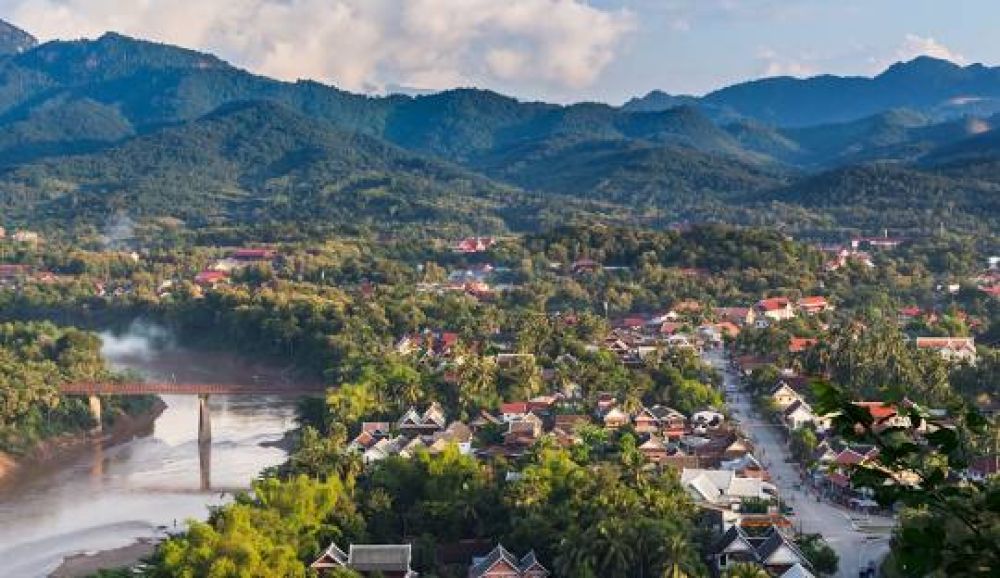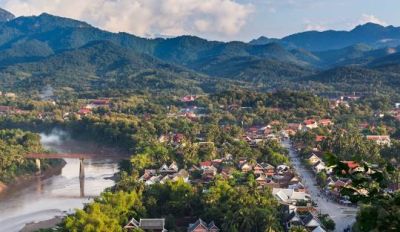

The Royal Palace Museum, also known as Haw Kham, is an essential site for history buffs and those interested in Lao culture and heritage. The museum, once the royal residence of King Sisavang Vong and his family until the communist takeover in 1975, has been well preserved and converted into a museum. It houses a collection of personal artifacts of the royal family, historical items, and gifts from other countries, including a moon rock given by the United States after the Apollo moon landing. The architecture is a blend of traditional Lao and French colonial styles, offering a glimpse into the past. As visitors explore the various rooms, they will discover the Throne Hall, the royal bedrooms, an assortment of Buddha statues, and ceremonial weapons. It's a great place to understand the history and how the past has shaped contemporary Laos.
Mount Phousi stands as a prominent hill in the center of the historical town of Luang Prabang, and is a top attraction for both locals and tourists. Climbing up the 300+ steps to the summit provides not just a mild workout, but also a chance to visit several Buddhist shrines along the way, including the famous Wat Chom Si temple at the top. Upon reaching the peak, climbers are rewarded with a breathtaking 360-degree panoramic view of the town, the Mekong and Nam Khan rivers, and the distant mountains. It is especially popular at sunset, when the skies become a canvas of vivid colors. Visitors should also explore the hill at dawn when the view of the mist-laden landscape can be a serene experience. This climb is an absolute must-do for any traveler visiting Luang Prabang.
A visit to the Pak Ou Caves, located at the confluence of the Mekong and Nam Ou rivers, is an amazing journey that combines a scenic boat trip with cultural exploration. Known locally as 'Tam Ting,' these two caves (the lower Tham Ting and the upper Tham Theung) have been a place of worship for thousands of years and are filled with hundreds of ancient Buddha statues, ranging in size from a few centimeters to several feet tall. The statues have been placed by pilgrims over the centuries, giving the caves an extraordinary atmosphere. During the boat ride, visitors will also enjoy the magnificent limestone cliffs and the serene riverside lifestyle. Exploring Pak Ou Caves provides a unique insight into the spiritual traditions of Laos and is a peaceful retreat from the busier tourist spots in Luang Prabang.
For food enthusiasts, taking a traditional Lao cooking class in Luang Prabang is the perfect way to dive into the flavors of Lao cuisine. These classes often begin in the morning with a visit to the local market accompanied by a chef who teaches about the ingredients used in Lao cooking. Participants then proceed to a cooking school where they learn to prepare several traditional dishes such as Mekong fish in banana leaves, sticky rice, and classic Lao salads. Classes include hands-on instruction and typically end with students enjoying the meal they've prepared. This activity is not just a culinary lesson but also a cultural one, offering insights into the country's food traditions and daily life. The skills learned are a fantastic souvenir, allowing visitors to recreate Lao dishes for friends and family back home.
The Kuang Si Falls are arguably the most famous attraction near Luang Prabang, captivating visitors with their cascading turquoise waters and lush tropical surroundings. The falls are a three-tiered waterfall with several pools that are perfect for swimming and relaxation. On-site facilities include changing rooms and picnic areas, making it ideal for a day out in nature. There's also a bear rescue center nearby, where visitors can see Asiatic black bears that have been rescued from poachers. The short hike to the top of the falls offers great views and photo opportunities. Visitors should be aware of the slippery paths, especially during the wet season. The beauty of Kuang Si Falls has to be seen to be believed, and its tranquil ambiance provides a refreshing escape from the heat of Laos.
Wat Xieng Thong is one of the most important temples in Laos, renowned for its intricate design and historical significance. Located at the tip of the peninsula where the Mekong and Nam Khan rivers meet, the temple was built in the 16th century and has remained a significant monument for religious and cultural events, such as the annual Lao New Year celebration. The temple complex features several ornate buildings with elaborate mosaics, including the stunning 'tree of life' glass mosaic on the rear wall of the main temple. Inside, the temple houses a collection of rare Buddhist artifacts and traditional art. The architecture and decoration reflect the richness of Laotian craftsmanship. A visit to Wat Xieng Thong is a must for anyone interested in the art, history, and religion of Laos.
The Alms Giving Ceremony, known locally as 'Tak Bat', is a revered tradition in Luang Prabang and a profound experience for visitors. Taking place daily in the early morning, this ritual involves the town's Buddhist monks walking in a silent procession through the streets as locals and respectful tourists offer them food. This serene event is a way for the community to support the monks, who are not allowed to cook or purchase their own food, and for the participants to gain spiritual merit. Visitors can join the ceremony by offering food, but it's vital to follow local customs—dress conservently, remain silent, avoid physical contact with monks, and give with respect. Observing this centuries-old practice offers a glimpse into the spiritual heart of Laos and the country's deeply embedded Buddhist traditions.
The Luang Prabang Night Market is a vibrant showcase of Lao craftsmanship and a fantastic spot to shop for souvenirs and gifts. Situated along Sisavangvong Road in the town center, the market is open every evening and is teeming with stalls selling a diverse array of handmade textiles, clothing, jewelry, artworks, and traditional crafts. The market provides an opportunity to interact with local artisans and to learn more about the materials and techniques used in their creations. Shopping here also supports the local community and preserves traditional crafts. In addition to the handicrafts, the night market is a great place to sample local street food and delicacies. For an authentic shopping experience that is as much about the atmosphere as it is about the unique finds, the Luang Prabang Night Market is an activity that should not be missed.
Cycling is a fantastic way to explore Luang Prabang and its surrounding areas at a gentle pace. Rent a bike or join a guided bike tour to discover the city's charming streets, local life, and hidden spots. Along the way, you can stop at temples, river viewpoints, and traditional villages. Experienced guides can offer a deeper insight into the history and culture of each site. A typical tour might include a ride along the Mekong River, stops at artisan communities, and a visit to the local market. Biking allows you to see more in less time and to enjoy the natural beauty of the region. It's a healthy, eco-friendly option suitable for most fitness levels, and provides a chance to truly connect with the laid-back atmosphere of this UNESCO World Heritage city.
Taking a sunset cruise on the Mekong River is one of the most romantic and peaceful activities in Luang Prabang. As the sun begins to set, the river is bathed in golden hues, and the silhouette of karst mountains provides a dramatic backdrop. During the cruise, guests often enjoy Lao snacks and refreshments, and sometimes live music. The slow-paced journey allows for a leisurely appreciation of the Mekong’s importance to the people of Laos and the stunning scenery it traverses. This experience offers a timeless moment to reflect on the beauty of nature and the simple pleasures of life. Whether you're seeking a tranquil evening or a picturesque end to a busy day of exploration, a sunset cruise on the Mekong is an experience that embodies the essence of Luang Prabang.
